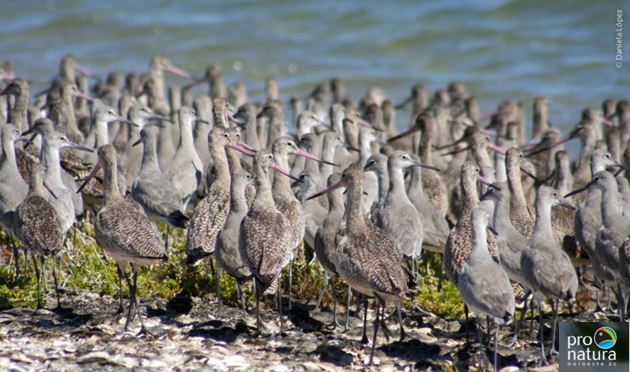This article was originally published by Pronatura Noroeste and is reposted with permission.
The coastal lagoons of the El Vizcaíno region (Guerrero Negro, Ojo de Liebre, Laguna San Ignacio, El Coyote, La Bocana), in Baja California Sur, receive the highest concentration of wintering shorebirds in northwest Mexico. In order to strengthen the conservation schemes in those wetlands, the El Vizcaíno Biosphere Reserve has agreed with the Baja California Sur State University and Pronatura Noroeste to implement a work plan that responds to the guidelines of the Pacific Americas Shorebird Conservation Strategy.
This strategy, drawn up by experts from 15 countries, makes it possible to unify and coordinate shorebird conservation efforts at the continental level. This represents a fundamental element because they are highly migratory birds, which depend on the maintenance of each and every one of the wetlands that they use along the eastern coast of the Americas.
Everardo Mariano, Director of the El Vizcaíno Biosphere Reserve, commented that, “The coastal lagoons of El Vizcaíno, fundamental for the conservation of 33 species of migratory shorebirds, have been distinguished as Priority Wetlands according to the Ramsar Convention, Areas of Importance for Bird Conservation, and Sites of Hemispheric and International Importance in the Western Hemisphere Shorebird Reserves Network. The National Commission of Natural Protected Areas (CONANP), through the El Vizcaíno Biosphere Reserve, collaborates with the responsibility of conserving these sites, for which the continental strategy that we are now adopting represents an extremely important tool.”
Shorebird conservation actions in the El Vizcaíno Biosphere Reserve have the advice of Dr. Roberto Carmona, researcher at the Baja California Sur State University and Scientific Director of the Pronatura Noroeste’s Bird Conservation Program. Dr. Carmona was honored by the Western Hemisphere Shorebird Group in 2019 with the Lewis T. Oring Award, for his contributions to shorebird research. A large part of Dr. Carmona’s research was carried out precisely in the El Vizcaíno wetlands.
The El Vizcaíno Biosphere Reserve is the first natural protected area in Mexico to adopt the Pacific Americas Shorebird Conservation Strategy, also incorporating this group of birds as one of the main conservation objectives in the new edition of its Management Program.
Among the actions considered in this strategy is the signaling and protection of sites used by shorebirds during their wintering in the coastal lagoons of Ojo de Liebre and San Ignacio, training for teachers, instructors, park rangers and tourism companies for the conservation of these birds and their habitat, and bird monitoring activities in those wetlands. In this last issue, the installation of a network of monitoring antennas called “Motus stations” stands out, which will allow the permanent and automatic detection of migratory birds, with which the El Vizcaíno Biosphere Reserve will be integrated into the international bird monitoring network that will extend along the Pacific coast of the American continent.
For more information, please contact Everardo Mariano, Roberto Carmona, or Gustavo Danemann.

